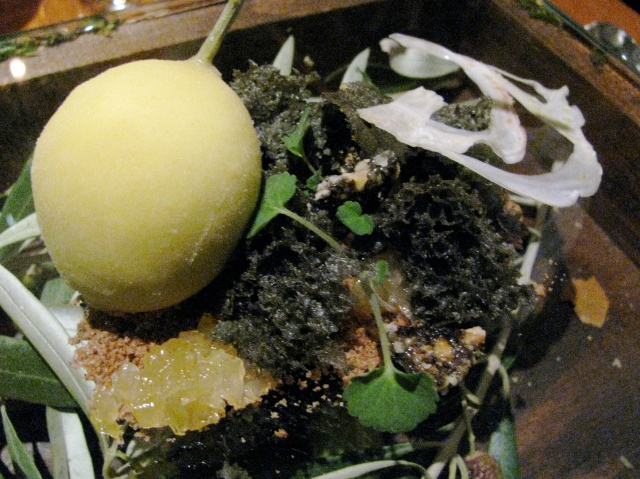Last November I had the pleasure of joining other Bay Area media for an unforgettable dinner at Michelin-starred Atelier Crenn. Our dinner was part of a US tour put on by Foods from Spain, part of the Trade Commission of Spain. It was a great reintroduction to the variety of Spanish extra virgin olive oils that are available to home cooks. Our hosts for the evening were Mercedes Lamamie, Associate Marketing Director for the Trade Commission of Spain’s New York office, and Raquel Diaz Cepero, Marketing Manager of Madrid’s non-profit organization, Interprofesional del Aceite de Oliva Espanol, which promotes the merits of Spanish extra virgin olive oil and represents the many players of this high-stakes global commodity. The exciting venue selection was due in part by Dominique Crenn’s recent exploration of the vast olive growing regions of Spain. She and other noteworthy American chefs were invited to tour and learn about Spanish olive oil from the source back in 2011.
Spain produces more than 262 varieties of olives, 24 of which are used for olive oil. Upon arrival, we were asked to taste the four most commonly used: Picual, Hojiblanca, Arbequina, and Cornicabra. Initially, we tasted with bread but soon we were asking for spoons to get a more accurate flavor profile. It turned out to be an important exercise since soon after the magic from Dominique’s kitchen emerged with four courses of amazing Spanish olive oil-infused food.
Each of the four oils have unique characteristics and uses in the kitchen.
- Picual is full-bodied with a peppery bite. It is said to be the best for frying. I prefer it as an everyday eating oil, appropriate for all applications.
- Hojiblanca is a bit more mellow than Picual and is more readily available to American cooks. Unfortunately, it can be pricy so save it for finishing applications such as salads and dipping. It’s great on steamed vegetables.
- Arbequina is the perfect finishing oil. A good balance of buttery, mellow and vibrant green tartness. Another pricy, but worthy oil to enjoy.
- Cornicabra is the utilitarian oil of Spain, but barely known here in the states. I have never come across it here, but did enjoy it, though I wouldn’t seek it out with the others more readily available.
This was our amuse, a white chocolate shell filled with pressed apple cider and topped with a creme de cassis concentrate. No olive oil here, just sheer joy as the entire morsel is popped in the mouth and explodes with the slightest pressure. Kind of like if a water balloon exploded in your mouth. Nothing I’ve ever experienced.
Our first course, above, was Hamachi, celery-apple, caviar, crustacean and beet broth. Dominique used the Cornicabra oil here in the broth and in the celery-apple sorbet. The fennel pollen on top of the hamachi gave a floral note and added lightness to the three types of caviar used. The Cornicabra was also used as a marinade for the fish as well as a frying medium for the lardo that was hidden beneath the fish.
Our second course was Tomato, Olive Rock and Chevre and used Arbequina in the tomato broth. The photo doesn’t do the dish justice as the tomatoes were present in a sorbet, in dehydrated form, and in the broth. The chevre were formed as “pearls” and the olive rock was like nougat. Cucumbers and mint lent freshness.
The third course, Pigeon, sunchoke, shellfish, and huckleberry used Picual oil. Dominique used Sonoma Valley squab and poached it in the Picual and then gave the breast a quick sear before slicing and serving. The rich liver quinelle was balanced by the acidity of the huckleberry sauce, and the sunchoke puree lent an earthy note.
This is Fallen Olive. Dominique often uses these custom-built shadow boxes for her dessert. Needless to say, applause ensued when these were presented. An edible composition for the books.
This is the edible portion of the composition. Dominique used Hojiblanca in the lemon sorbet and black olive and hazelnut nougat that resembles “dirt”. The Meyer lemon granita is sprinkled around and the black “rocks” is actually fennel chiffon cake.
Thank you Spain. Thank you Dominique for an amazing meal and evening. No go out and enjoy some Spanish olive oil!








This reminds me of a 10 course meal I had in Barcelona at ABAC. Yum!